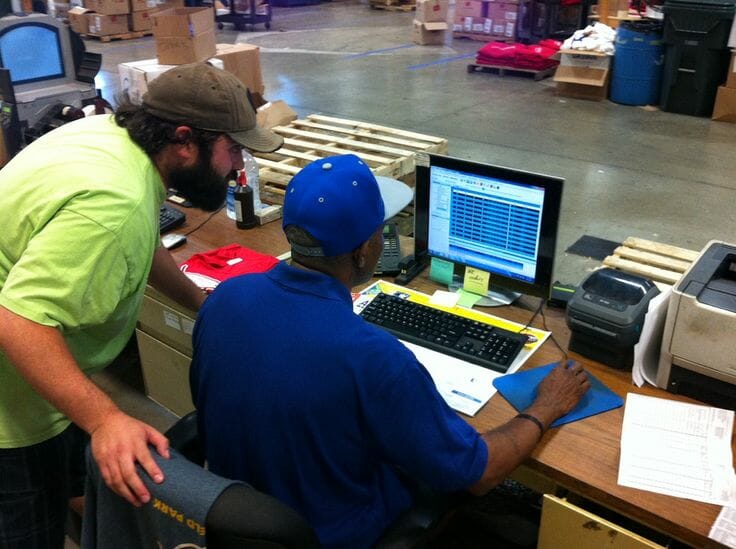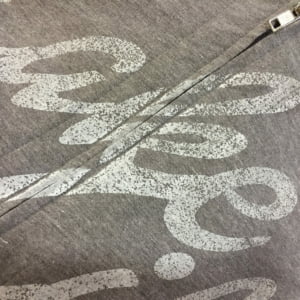There is a term in manufacturing or business called “Management By Walking Around”, or sometimes MBWA. This is a style of business management that is often discussed in business texts, but random and surprise visits by the boss date back to ancient history. For smaller apparel decoration shops without a lot of employees, this probably isn’t as applicable to your shop as it is for shops with a lot of employees focused on their work. The more employees you add, the larger the disconnect can be between the actual work and some key decisions by the owners or top brass.
What’s the problem? If you take the time to tour your shop you can discover the things aren’t quite working the way they should. These are usually the little details that won’t make it up through the proper channels and can only be discovered by observation, talking to employees, or helping out and doing the work. People usually just want to do a good job and they will invent their own remedy, or put up with a small inconvenience to push through a problem. Your job as a manager is to discover the pebble in their shoe. For example, a few weeks ago I noticed one of our top press operators measuring the distance between the print and the collar of a shirt to ensure proper print location. This is a good thing, except he was using a scrap piece of metal with marker tics on one edge for where the inches should be indicated. Evidently he’s been using this for the longest time and nobody has ever requested a new T-square for him to use for set ups. He invented his own. While I applaud his tenacity in making things work for him, using a proper tool for the job is important. You should have seen the smile on his face when I gave him a new T-square. Pebble removed.
Take the time. This daily exercise shouldn’t be timed or scheduled. This is especially true if you are an owner of a shop. You need to spend the time wandering around. Ask questions. It doesn’t have to be all business either. Get to know your employees. Find out about their lives and their interests. A good chunk of our staff is Hispanic, so I get to practice some “muy mal español” every day. It’s really fun and engaging to try to get through a conversation. The goal though is for our staff to learn more English, so by showing them that I’m willing to stumble through the language and laugh about it, I set the standard for trying. Smiling your way through failure like this gets more people to try new things. I’m really horrible though, as I can’t roll my r’s. As I want more of the Hispanic staff to practice English, we try to get them to do this with “No Español Viernes” (No Spanish Fridays).
Applaud Their Effort. Sitting in your office, intently scanning metrics from a spreadsheet, you can’t see what’s really going on daily on your shop floor. On some days the amount of work that has to be churned out, decorated and shipped is truly herculean. There is a huge difference between being there and helping sort through the madness, and just noticing an uptick in the numbers in your system. Applaud the effort. Congratulate them on a job well done. Say Thank You. It’s extremely important that you make the time for the positive interaction. This is what builds a positive “Let’s Get It Done” culture. Be mindful of the moment.
Things Have a Domino Effect. Sometimes you have to have your detective cap on to discover the real reason behind an odd circumstance. For example, your screen-printing department could be slightly behind on their schedule. Normally, they do a great job staging work early and getting things set up in advance to meet deadlines and ship dates. This week though, they are behind. Why? By observation and discussion, you unearth that one of the factors is that the screens aren’t coming out of the screen making department fast enough. You backtrack through the screen room, but they are caught up with the jobs that are approved and ready to run. Then the real issue surfaces; jobs aren’t getting approved fast enough by the customer and the delay is caused by the art approval process. Working with the art department and customer service, a new workflow for art approvals is developed with more emphasis on follow up after the art approval is sent. In a short amount of time, the challenge is resolved and things are back on track. The lesson here though is that you have to follow the thread and see where it is going to take you to the resolution for the challenge. Simply screaming “Work Harder!” doesn’t help. (By the way, screaming never helps.)
Observe and Take Notes. Just be open to what’s happening in front of you. Why do we do it that way? Where’s that guy going? What can we do to set that work group up for success? Your observation can lead to some interesting questions on how your shop can be more productive. Quite often, the workers and work team management are so focused on getting orders processed that they can’t see the bigger picture. If you are a leader for your company, it’s your job to determine what questions should be asked and a hypothesis for the solution to increase efficiency and work team effectiveness. You have to be present to do this and MBWA is the tool that allows you to get the information you need to continually discover the tweaks that will make your company work better. How quickly does the shop get going in the morning? Who is always late coming back from break or lunch? How long does it take to mix a bucket of ink? What happens when a screen rips on press? Do you have a back-up if there’s an international shipment and your main shipping clerk is out sick? What do you hand a customer at the front desk if they are asking about prices? Why is that person using cutaway stabilizer to sew a hat? You just hired a new staff member, what’s the on-boarding process? How many Pantone books are on the floor – and are they being used? Take notes. Take pictures. More importantly talk to your staff.
Owners – this is for you. You have to be present in your company. The best shops that I have seen or worked with over the years, all have an ownership in the company that is present and engaged. You don’t necessarily have to be doing the work, but you need to be in the shop on a regular basis and observe. If you are an owner that only occasionally sets foot in the shop, but yet you are making crucial financial and strategy decisions for your company, you are on a fool’s errand. You need to understand the complexities of the shop, comprehend the workflow, and observe the process for yourself. Regular engagement keeps you informed, and allows you to comprehend the nuances of the industry more than just reading the balance sheet. An uninformed position in the company is a long term strategic disaster. Jump in and get involved today!
Tips to get started:
- Make it routine. Have some sort of plan on what you are trying to discover, but make getting out from behind your desk and out onto the shop floor, a major part of your day. Bring a pen and some paper. Take notes on what you discover and follow up on the items you jot down.
- Talk to everyone. You are naturally going to talk to your managers, as they will have the key information on how the production schedule is going, supplies that are low, equipment that’s not working right, or employee issues. The real gold is with the rest of the staff. Ask them questions. Get to know them personally, so don’t just chat about work stuff. Does your equipment run ok? How do your managers treat you? One of my favorites is to ask them a wrong question about the job they are running and see if they give me the right answer.
- Ask for suggestions and ideas. Your staff knows their jobs and how to do it. They are right there every day churning out the work. What would make it easier for them? How could we do this task faster?
- Follow up with answers. This is crucial. Don’t just ask things and then never return, as that makes you an “askhole”. Whatever you discuss, try to find the answers and get back to them. No matter what. For example, I had a conversation the other day about cornbread with one of our staff members, so I looked up and printed out my favorite cornbread recipe, and hand wrote an addition (to not forget to dice up some jalapeños) and gave it to her. It was a fantastic laugh and moment, and I think she was really happy that I took the time to remember our conversation and follow up on it. This wasn’t necessarily a workplace effectiveness discussion; however these types of interactions break down employee/management barriers and get them to open up to you about other ideas.
- Don’t criticize. Remember, always publically praise and privately condemn. Your MBWA exercise is not about criticizing your employees as they are working. Jot down what you see and speak to your department managers or leads at a later time. However, if you do see someone doing something that could injure themselves, or will jeopardize the job being run correctly…absolutely step in and correct it. Make sure you use this as a training moment. No yelling or screaming.
- Closed circuit cameras aren’t the same as being there. With the advent of technology you can see what’s going on with your shop right from your phone these days. This is great if you want to check to make sure everyone is working, inventory is secure, or watch for efficiency challenges. However, you can’t see everything and you certainly can’t understand what is being discussed as there’s no sound. Cameras are great, and a good tool to have. However, nothing replaces direct observation, candid discussions, and focused follow up for mitigating challenges and improving your shop.
So, here’s your challenge: get moving and out walking around the shop. Do it a few times a day. Get engaged and learn. Observe things with a critical eye, and ask good questions. Follow up and make changes for the better. You can do it!




